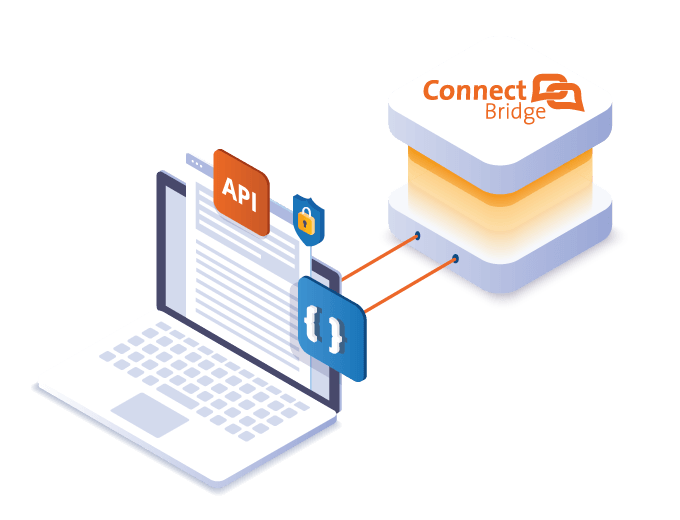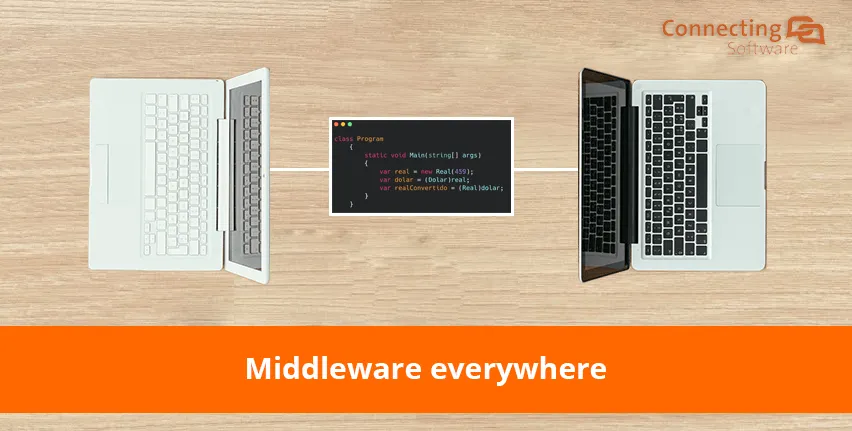Do you hear about middleware everywhere, but you are not sure what it is? Let’s start there and define middleware.
Middleware definition
It is not so easy to define middleware as you might think. In general, middleware is software that can link two separate applications together. It is in the middle of those applications, thus the term “middleware”.
The thing is that the term middleware has evolved and is now used in a wide variety of ways. Therefore, the best way to understand what “middleware” means is to analyze where it came from and discuss some specific examples of how it can be used. Let’s have a look.
Evolution of middleware technologies
The first generation of middleware dated from the mid-1980s when distributed systems started replacing aging mainframes. At that time, the term “middleware” referred to software that sat above the operating system and networking software and below specific applications.
In a way, middleware was, at that time, bridging the gap between the operating system with networking and the application, easing the development of distributed applications.
Traditional middleware software included Remote Procedure Call (RPC) middleware, Message Oriented Middleware (MOM), Transaction Oriented Middleware (TOM), and Distributed Object Middleware (DOM).
We could call this traditional view of what middleware is a vertical view. The operating system (including basic communication protocols) was at the bottom, and the distributed applications were at the top. Middleware was in the middle of these.
Current middleware applications
The contemporary view of what middleware is has more of a horizontal approach. In this approach, middleware sits in the middle of a sea of distributed components, such as applications and databases.
Middleware serves as the glue and allows this multitude of components to interact with one another.
Common middleware examples include database middleware, application server middleware, web middleware, and transaction-processing monitors. When you look at it, there seems to be middleware everywhere these days.
Let’s have a look at one of these examples of middleware, database middleware, sometimes also called database-oriented middleware. This is the middleware that facilitates communications with a database, allowing the end software to extract information from either local or remote databases. The application accesses through a single common interface such as ODBC or JDBC.
Middleware products
Requirements for faster development cycles, decreased effort, and greater component reuse drive the creation and use of middleware products and tools.
These middleware tools’ primary role is to enable and simplify the integration of components developed by multiple technology suppliers.
When appropriately implemented, middleware tools can help to:
- Shield software developers from tedious and error-prone platform details.
- Amortize software lifecycle costs by leveraging previous investments and developments.
- Provide a consistent set of higher-level abstractions that are much closer to application requirements and therefore simplify development.
- Provide a broad array of developer-oriented services, such as security that are necessary but take up a lot of development effort.
But while the advantages of middleware products are clear, there are also some concerns.
The most frequent concern is performance. Yes, it is nice to have this ability to connect applications seamlessly, but how much will it “cost” us in terms of performance?
Connect Bridge – a middleware tool to build middleware
Connect Bridge is a middleware tool built by Connecting Software that allows you to create your custom middleware in any language with much fewer lines of code.
Want to build a Java middleware? That’s supported. Want to build a Node.js middleware? That’s supported too. And the same goes for any language that can access a database using ODBC, JDBC, or Web Services. If it can, using that language + Connect Bridge is a sound alternative for building that middleware.
Let’s see how it works. Typically, when building a middleware, the developer needs to use the API of the software he is connecting. The idea behind Connect Bridge is that the developer stops writing code for the API and starts writing standard SQL statements instead. Connect Bridge translates the ANSI standard SQL syntax into the appropriate API calls.

OK, this is a more convenient way to build the middleware, but does it come at a performance cost?
Thomas Berndorfer, CEO of Connecting Software, explains: “The idea of Connect Bridge is to make it very simple and fast. It is fast for the developer because they can become integration heroes in 3 hours. After all, they remain in their language and have to learn nothing new. We also wanted to make the resulting software fast. Performance and security were major concerns from the beginning.”.
Another advantage of using this kind of middleware tool is compatibility. A classical problem of middleware was the changes to the API, usually caused by upgrades to the underlying software. Having Connect Bridge shields the developers from these changes, as it is Connect Bridge that handles them. This is one of the main reasons why the tool is cost-effective. If you want to know more about pricing, fill the short form here.
Takeaway
Using a middleware is a more modern way of tackling integration projects. It allows for faster development of the final integration solution, and it ensures that the solution has fewer errors and is easier to maintain. In summary, using a middleware means better ROI for your integration project.
To see how this works for yourself, think of which software you would like to integrate and ask for a free demo.
